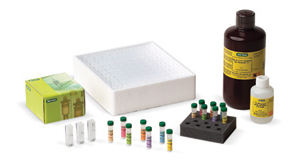
Overview
A full range of protein analysis kits is available for protein extraction, quantitation, separation, and analysis using techniques such as polyacrylamide gel electrophoresis, western blotting, and ELISA.
Category Products
- Image
 Engineering Solutions for Global Health Kit
Engineering Solutions for Global Health KitIn this engineering kit, students measure protein content in foods and design solutions to a complex, real-world problem — malnutrition.
- Image
 Got Protein? Kit
Got Protein? KitBased on the Bio-Rad Quick Start Bradford protein assay, this kit is designed to introduce students to proteomics and provides the tools for them to develop their own protein-based experiments.
- Image
 ELISA Immuno Explorer Kit
ELISA Immuno Explorer KitExplore the enzyme-linked immunosorbent assay (ELISA) and its ability to detect antigens or antibodies for a wide range of applications.
- Image
 Giant Panda Problem Kit for AP Biology
Giant Panda Problem Kit for AP BiologyInvestigate immunology and endocrinology while monitoring giant panda fertility with ELISA. Includes curriculum and materials to support structured, guided, and open inquiry. Covers Big Ideas 2 and 4.
- Image
 Biofuel Enzyme Kit
Biofuel Enzyme KitThis kit explores enzyme kinetics associated with the production of cellulosic ethanol, a biofuel, and provides support for a structured, teacher-driven approach.
- Image
 Biofuel Enzyme Reactions Kit for AP Biology
Biofuel Enzyme Reactions Kit for AP BiologyExplore enzyme kinetics associated with the production of cellulosic ethanol, a biofuel. This ThINQ! Kit provides support for an open or guided inquiry format, enabling a student-driven learning approach. Covers Big idea 2 and 4.
- Image
 Size Exclusion Chromatography Kit
Size Exclusion Chromatography KitColumn chromatography is the most common method used in biotechnology for separating a mixture of components in a liquid.This kit teaches the basic principles of size exclusion chromatography.
- Image
 Comparative Proteomics Kit I: Protein Profiler Module
Comparative Proteomics Kit I: Protein Profiler ModuleThis module allows students to employ protein electrophoresis, the most widely used technique in life science research, to study protein structure and function.
- Image
 Comparative Proteomics Kit II: Western Blot Module
Comparative Proteomics Kit II: Western Blot ModuleStudents use western blotting to specifically identify myosin light chain from the hundreds of other proteins that comprise the muscle cell extracts of closely and distantly related species of fish.









